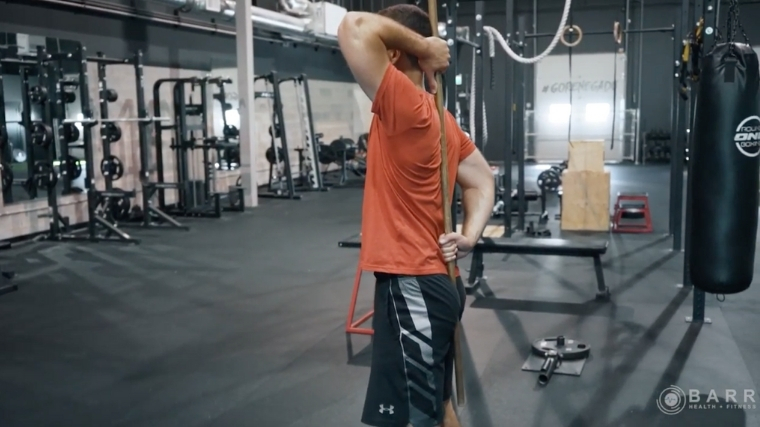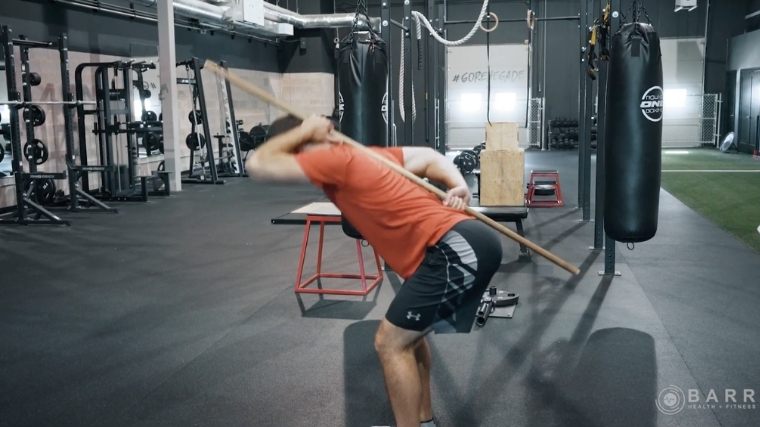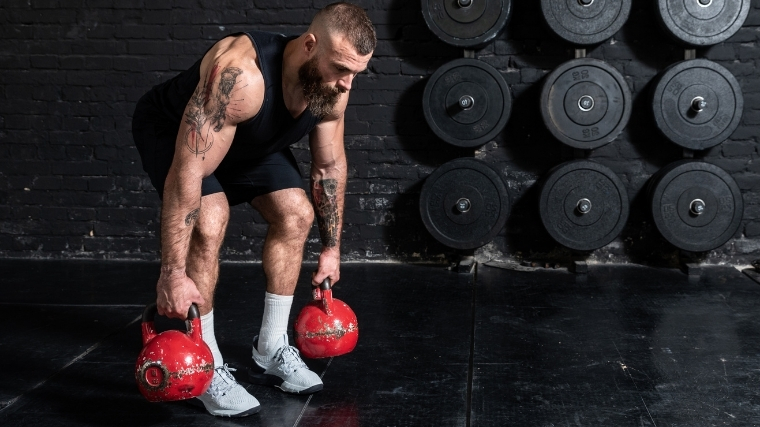The hip hinge is more than an exercise. It’s a fundamental movement necessary for success in the deadlift, Olympic lifts, and more. Lifters can unlock their strength potential and protect themselves from injury by mastering the hip hinge early in their career and often keeping it in their program.
For strong hamstrings, a healthy back, and a huge deadlift, the hip hinge is a must. In this article, we’ll cover everything you need to know about the hip hinge, including:
- How to Do the Hip Hinge
- Benefits of the Hip Hinge
- Muscles Worked by the Hip Hinge
- Who Should Do the Hip Hinge
- Hip Hinge Sets, Reps, and Programming Recommendations
- Hip Hinge Exercises
- Frequently Asked Questions
How to Do the Hip Hinge
The Romanian deadlift is the best example of a pure hip hinge exercise. To benefit from this exercise and its variations, you need to develop pristine hip hinge technique. Working with a dowel rod is a great way to lock in your hinge technique before adding weight in the form of deadlifts.
Step 1 — Setting Up the Hip Hinge

Place the dowel rod on your back to make contact with your head, your mid-back between your shoulder blades, and your lower back. Place your hands wherever they are comfortable. Dowel rods are ideal, but something similar like a broomstick works just fine.
Form Tip: To fold forward while maintaining contact with the rod, most lifters will need to bend their knees. Although the knees do bend, they do not project forwards. Think of this as a softening of the knees to allow the hips to project backward. Keep your feet flat and solid on the ground as your weight shifts.
Step 2 — Fold at the Waist

Fold forward at the waist, bringing your chest down towards the floor while maintaining contact between the rod and the three points of contact — the tailbone, mid-back, and head. You want your spine to maintain the same shape and position that it has while you are standing. Stop when your chest is about parallel to the ground, and you feel a stretch in your hamstrings.
Form Tip: Although there are times when lifters can deviate from a true neutral position safely, it is wise first to familiarize yourself with a neutral position so that any deviations from the neutral position are deliberate and not a result of poor technique.
Step 3 — Stand Back Up

Once you’ve reached the bottom position, push your hips forward to stand back up. Fully extend but do not overextend the hips. Squeeze your glutes as you approach the end of and complete the rep. The dowel rod is a tool to help you learn how your own optimal hinging movement pattern. Once you have a strong sense of the movement, the next step is to add some weight.
Form Tip: When you add weight, be sure to keep the weight close to you by engaging your lats. The hinge is a great opportunity to start developing the skill of lat tension required for successful deadlifting. Progress from kettlebell or dumbbell variations to the barbell when your strength allows.
[Related: Everything You Need to Know to Build Your First Workout Program]
Benefits of the Hip Hinge
The hip hinge builds a strong and resilient posterior chain. Working on hip hinge-based exercises like Romanian deadlifts can build muscle, enhance athletic performance, increase strength, and improve resistance to injury. Here are some of the main benefits of the hip hinge.
Hamstring Length and Strength
The hip hinge has a strong eccentric component, where the lifter resists the pull of gravity to lower the weight under tension and control. Eccentric training of the hamstrings helps make them stronger and increases their resilience to injury (1). Eccentric training can also increase muscle fascicle length and allows the hamstrings to function optimally, allowing the lifter to avoid movement compensations — where other muscles take over to complete a lift when the target muscle is too weak — in certain positions.
A Stronger, Safer Deadlift
A solid hip hinge is a critical component of the deadlift. Lifters who begin to train conventional deadlifts before mastering the hip hinge will be shortchanging themselves and leaving themselves vulnerable to injury. Having a strong hinge helps lifters keep their deadlifts efficient and help prevent technique breaking down with heavier loads, resulting in an injury.
Spine Health
The ability to hinge properly means keeping your spine neutral. This is especially important in the gym and when picking up objects like a heavy grocery bag without a rounded spine. Using a hip hinge for day-to-day tasks means less wear and tear on the spine. This means a lower risk of injury and being able to push it that much harder in your training sessions.
Muscles Worked by the Hip Hinge
The muscles worked in a hip hinge-based exercise vary somewhat depending on the exact exercise. Regardless of the variation, all hip hinge exercises primarily train the hamstrings, glutes, and muscles of the lower back, known as the posterior chain.
Hamstrings
The hamstrings are the prime mover in the hip hinge. The hamstrings originate from the ischium (the base of the pelvis) and insert on the tibia and fibula. As you hinge forwards, the origin of the hamstrings moves upwards, away from the insertion, increasing length and tension on these muscles.
Glutes
The glutes are not subjected to the same extent of stretch or eccentric overload as the hamstrings, but they are involved and trained in the hip hinge. The hip hinge can help strengthen and develop the glutes. It’s useful to train the hamstrings and glutes to work together since they often do so in the weight room, sport, and day-to-day life.
Lower Back
The muscles of the lower back are also called the spinal erectors. Although they do not generate movement in the hip hinge, they work isometrically to help maintain the strong spinal position throughout the movement. This helps develop strength and endurance in this important muscle group.
[Read More: Best Lower Back Exercises for Strength and Reduced Pain]
Who Should Do the Hip Hinge
Everyone! As long as you can perform the movement without pain and compensation, everyone can benefit from having the hip hinge in their program.

Strength Athletes
The muscles and movement pattern of the hip hinge helps strength athletes reach their peak potential in exercises like the deadlift and Olympic lifts. It is also a great way to overload the hamstrings. Stronger hamstrings can help improve performance in any lower body exercise, including squats.
Sport Athletes
Pulled hamstrings are an epidemic in field sports like soccer and football. Eccentric training of the hamstrings, as seen in variations of the hip hinge, is a useful strategy for preventing hamstring tears, particularly when done in conjunction with other eccentric exercises like Nordic curls and also well-designed sprinting workouts.
General Population
Even people who don’t lift can benefit from learning the hip hinge. This fundamental movement pattern can help people protect their spines when performing daily tasks like picking objects up off the ground.
Hip Hinge Sets, Reps, and Programming Recommendations
There are many different hip hinge exercises, which means there is a world of options for programming them. Here are some general programming recommendations for hip hinge exercises. Treat these as a reference point and adjust them as needed to fit in your program.
To Increase Strength
The barbell Romanian deadlift is an excellent option to build strength in the hip hinge. Three to six sets of five to eight repetitions with two minutes of rest between sets is a good approach when using this exercise to increase strength. Doing this exercise with loads heavier than a 5RM is not recommended. A conventional deadlift is a better option for max strength work.
To Build Muscle
Any hip hinge exercise can be used to build muscle. Doing three to six sets of eight to twenty repetitions with one to two minutes of rest between sets is a good starting point. Time under tension is also an important driver of muscle growth, so exercises can be further manipulated using a slower tempo.
To Increase Muscle Endurance
Three to six sets of 15 to 30 repetitions of any hip hinge-based exercise will develop the local muscular endurance in the muscles involved in the hip hinge. Rest for 45 seconds to 90 seconds between sets.
Hip Hinge Exercises
Since the hip hinge is a movement rather than a specific exercise, there are many hip-hinge-based movements. Here are some of the more common and effective variations.
Barbell Romanian Deadlift
The Romanian deadlift is one of the most popular hip hinge exercises. Compared to standard deadlifts, which have you pull the barbell from the floor each rep, the RDL has you lower the bar to shin level. Therefore, you accumulate a lot of tension in the target muscles. In addition to the essential cues of maintaining a strong spine position, the key is to keep the bar close to you so that it travels straight up and down throughout the movement. Actively pull on the bar and keep tension in the lats.
[Related: The Best Barbells for CrossFit, Weightlifting, Powerlifting, Deadlifts, and More]
Cable Pull Through
The cable pull-through is a hip hinge variation that teaches the difference between a hinge and a squat and also develops the sense of a strong lockout position. Set the cable in the lowest position and attach a rope to the end of the pulley. Stand over top of the rope facing away from the machine. Grab the rope and walk forwards. Find a solid stance and hinge forwards, letting the arms get pulled back towards the cable. The cable pull-through is a useful teaching tool when learning the hinge, and also an effective accessory exercise and a great choice for higher volume sets on workout days that include hip hinging work.
[Related: The 8 Best Barbell Exercises for Mass, Strength, and Power]
Band-Resisted Hip Hinge
Band resisted hip hinges introduce accommodating resistance. The resistance band makes the movement harder as you approach the top position due to the band tension, which helps develop a strong lockout position. The feedback of the movement also helps enforce proper mechanics.
[Related: 4 Barbell Exercises You Should Try Adding Bands to]
Good Morning
The Good Morning is a hip hinge exercise in the same way as a Romanian deadlift, but the weight is on the shoulders instead of in the hands at the waist. This results in a different muscle activation pattern and is a good way to program variation to maximize overall strength and eliminate weaknesses. You can also load the good morning with sandbags (shown below), kettlebells, and dumbbells.
Hip Hinge FAQs
Why is the hip hinge so important?
The hip hinge is a spine-sparing technique that reduces wear and tear on the spine when completing day-to-day tasks and physical work. It is also an essential component of the deadlift. Learning the hip hinge early in your lifting career will help you stay healthy and achieve your true strength potential. Training the hip hinge as an accessory exercise will help increase deadlifting ability.
How often should I do hip hinge exercises?
The exact amount of hip hinge exercises you need depends on the overall structure of your training program. As a general rule, you will want at least one hinge variation in each training week at all times. Hip hinge exercises can be done as the main lift, like a heavy barbell Romanian deadlift. They can be done as a warm-up exercise or an accessory exercise using variations like the cable pull-through.
How strict do I need to be about Neutral Spine?
When performing the hip hinge, you want your spine to maintain the same shape and position while standing. This is sometimes referred to as a neutral spine. A neutral spine is a range of positions, not just one position, and there are times when lifters can lift safely outside of the neutral spine range. To ensure safety and skill mastery, it is wise first to become familiar with the neutral spine position so that any deviations from this position are well thought out and deliberate.
References
- Vianna KB, Rodrigues LG, Oliveira NT, Ribeiro-Alvares JB, Baroni BM. A Preseason Training Program With the Nordic Hamstring Exercise Increases Eccentric Knee Flexor Strength and Fascicle Length in Professional Female Soccer Players. Int J Sports Phys Ther. 2021 Apr 1;16(2):459-467. doi: 10.26603/001c.19452. PMID: 33842041; PMCID: PMC8016438.
Featured image: Srdjan Randjelovic/Shutterstock